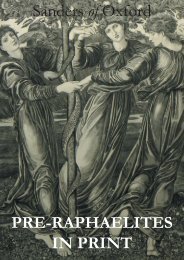You also want an ePaper? Increase the reach of your titles
YUMPU automatically turns print PDFs into web optimized ePapers that Google loves.
Censor Seal: Kiwame [‘approved]<br />
Publisher’s Seal: Eikyudo (also known as Yamamoto-ya Heikichi)<br />
School: Utagawa<br />
Method: Nishiki-e woodblock print<br />
Format: Single sheet ôban tate-e<br />
Condition: Excellent with fine detailing<br />
Dimensions: 15 x 9 3/4 inches<br />
Code: SOX<br />
Price [Framed]: £600<br />
A courtesan surrounded by the aki-no-nanakusa or ‘Seven Plants <strong>of</strong> Autumn’, the boundary<br />
between her kosode and obi rendered deliberately faint, thus suggesting that she too<br />
represent a seasonal bloom. The plants consisted <strong>of</strong> hagi [bushclover], susuki [pampas<br />
grass], kikyô [Chinese bellflower], kuzu [arrowroot] ominaeshi [maidenflower], nadeshiko<br />
[pinks or wild carnations] and fujibakama [boneset].<br />
First mentioned collectively in a poem by Yamanoue no Okura (ca. 660-733) from the<br />
eighth-century Man’yôshû [ca. 750], they were <strong>of</strong>ten contrasted with the ‘Seven Grasses <strong>of</strong><br />
Spring’ or haru-no-nanakusa. According to De Becker [1899: p.226], yûjo <strong>of</strong> the Yoshiwara<br />
<strong>of</strong>ten set out artificial representations <strong>of</strong> the aki-no-nanakusa in their rooms, the displays<br />
intending to evoke autumnal fields, thus setting a wistful seasonal atmosphere for their<br />
customers.<br />
28. Kikugawa Eizan (1787-1867)<br />
Flirting in the Street <strong>of</strong> Fabric Shops, Odemmachô Quarter<br />
Date [Western]: ca. 1840s<br />
Date [Japanese]: Tempô era<br />
Signature: Kikugawa Eizen-hitsu<br />
School: Utagawa<br />
Method: Aizuri-e woodblock<br />
Format: Single sheet ôban tate-e<br />
Condition: Good, some fading and slight rubbing on corners<br />
Dimensions: 15 x 10 inches<br />
Code: SOX<br />
Price [Framed]: £480<br />
The fabric sellers’ quarter in Edo was centred on Momendana [‘The Great Post Station’], as<br />
the First Street in the Odenmachô was popularly known. Situated next to the Nihonbashi<br />
[‘The Bridge <strong>of</strong> Japan’], the departure point for journeys along the Tôkaidô and the hub <strong>of</strong><br />
mercantile Edo, Momendana had been associated with textiles from the Genroku period. By<br />
Eisen’s day, First Street boasted around fifty wholesale stores, stretching in an unbroken line<br />
on either side <strong>of</strong> the road, each business identifiable only by curtains [noren] emblazoned<br />
with the trader’s name.<br />
In Eisen’s print, possibly once part <strong>of</strong> a triptych, a cross-section <strong>of</strong> Shitamachi [‘Low City’]<br />
life bustles along the Momendana: a townswoman selects rolls <strong>of</strong> material from an eager<br />
salesman, a beauty dressed in a seasonal iris-patterned kosode (indicating the Fifth Month),<br />
flanked by her maids, flirts with a handsome samurai, holding a fan picked up at the latest<br />
kabuki performance, and, surveying the scene, a wealthy merchant’s wife is transported in a<br />
kago [palanquin] by half-stripped bearers, sweating in the summer heat. As one proverb had<br />
it: 'The person who rides in the kago, the men who bear it; pain in the lower back, pain in the<br />
shoulders.'<br />
The distinctive aizuri technique, which entailed repeated printings in multiple shadings <strong>of</strong><br />
blue, was devised in 1842 to circumvent the draconian governmental sumptuary reforms.<br />
Aside from banning the colourful nishiki-e or ‘brocade’ prints, they also forbad the portrayal<br />
<strong>of</strong> yûjo, geisha and other demimondaines, which explains Eisen’s choice <strong>of</strong> a quotidian street<br />
scene ~ the beauty and iki <strong>of</strong> the women merely hinting at the models’ nightime occupations.












